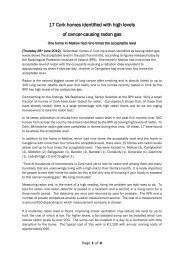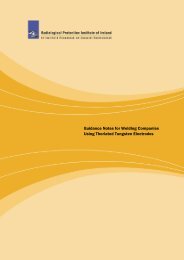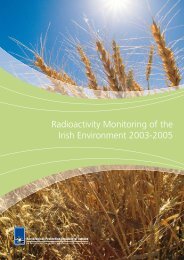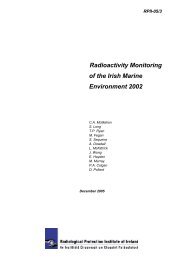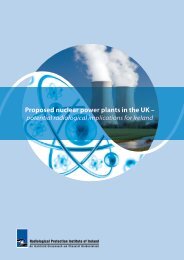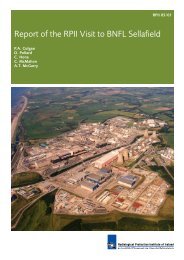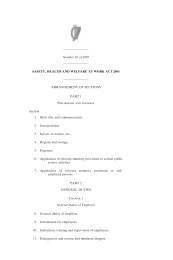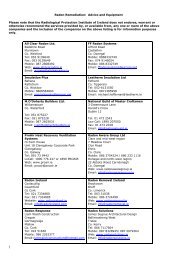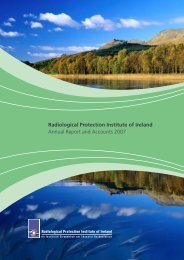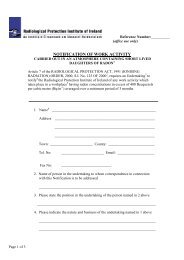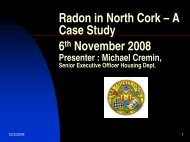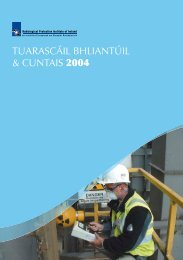Annual Report and Accounts 2006 - Radiological Protection Institute ...
Annual Report and Accounts 2006 - Radiological Protection Institute ...
Annual Report and Accounts 2006 - Radiological Protection Institute ...
You also want an ePaper? Increase the reach of your titles
YUMPU automatically turns print PDFs into web optimized ePapers that Google loves.
Chief Executive’s Statement<br />
In general, compliance with licence conditions by the 1581<br />
licensees was good. Two hundred <strong>and</strong> two inspections were<br />
undertaken during the year with the principal focus on those<br />
licensees who had not been inspected since 2003. A new<br />
development during the year was the review during inspections of<br />
the arrangements for the security of radioactive sources prompted<br />
by the concern internationally at the potential for the diversion of<br />
such sources for malevolent purposes. This work was assisted by<br />
An Garda Síochána <strong>and</strong> a joint work programme is expected to<br />
be agreed during 2007. The main areas of non-compliance during<br />
inspection included failing to revise radiation safety procedures<br />
<strong>and</strong> risk assessments, when new radiation sources are acquired,<br />
<strong>and</strong> failing to provide the necessary information about sources to<br />
the relevant authorities <strong>and</strong> the public. There was one prosecution<br />
for unlicensed custody of a nuclear moisture density gauge.<br />
During <strong>2006</strong> RPII continued to work towards achieving its mission<br />
of protecting people from the harmful effects of ionizing radiation<br />
through effective regulation, monitoring of the environment <strong>and</strong><br />
the provision of accurate <strong>and</strong> timely advice to the public <strong>and</strong> to<br />
Government.<br />
Regulation<br />
The number of new licences issued during the year was 105<br />
representing a steady expansion in the uses of ionising radiation in<br />
Irel<strong>and</strong>. Of particular note was the fact that three private hospitals<br />
were opened which when fully operational will offer a diverse<br />
range of radiological services. Plans are also advancing for the<br />
introduction of new radiological services to the public sector<br />
hospitals. Overseeing the establishment <strong>and</strong> maintenance of the<br />
appropriate radiation protection infrastructure for these hospitals<br />
will be a challenge for the RPII <strong>and</strong> other agencies involved in the<br />
regulation of medical uses of ionising radiation.<br />
An important element in radiation protection infrastructure is<br />
the rollout of the RPII’s register for Radiation <strong>Protection</strong> Advisors<br />
(RPAs) which was launched during 2005. By the end of <strong>2006</strong>,<br />
26 individuals <strong>and</strong> organisations had been approved to provide<br />
RPA services in the medical, dental <strong>and</strong> veterinary sectors. The<br />
formation of the register provides for the enforcement of the legal<br />
requirement that licensees appoint a registered RPA. During <strong>2006</strong>,<br />
all medical licensees were required to ensure that their RPAs were<br />
registered. In addition, all dentists were advised that, from the<br />
next licence renewal in September 2007, each dental practice<br />
will be required to appoint a registered RPA <strong>and</strong> to arrange for<br />
the RPA to review the arrangements for ensuring good radiation<br />
protection in the practice.<br />
The most serious incident reported during the year involved a<br />
case of “mistaken identity” where a quantity of the radionuclide<br />
technetium-99m used for a bone scan was administered to<br />
the wrong patient. In line with the conclusions of the hospital<br />
consultants, the RPII was satisfied that the health implications of<br />
the dose were not significant although the dose did exceed the<br />
dose limit for a member of the public. The RPII issued a letter of<br />
censure to the hospital <strong>and</strong> advised all medical licensees of the<br />
need to ensure that procedures for correct patient identification<br />
are available <strong>and</strong> implemented. The frequency of such incidents<br />
within the medical sector will be investigated further in 2007.<br />
Monitoring of the Environment<br />
The RPII’s environmental monitoring programme for <strong>2006</strong> showed<br />
that, with regard to the marine environment, the consumption<br />
of seafood continued to be the main pathway contributing to<br />
public exposure arising from artificial radioactivity in the marine<br />
environment with caesium-137 accounting for approximately<br />
60-70% of the total dose. The mean annual committed effective<br />
dose to a heavy consumer of seafood from the Irish Sea was<br />
found to be 0.75 µSv, representing less than 0.1% of the dose<br />
limit for members of the public of 1000 μSv (1 mSv) from artificial<br />
sources of radiation. A study of caesium-137 <strong>and</strong> technetium-99<br />
concentrations in seawater around the coastline was carried out<br />
in collaboration with the Environment <strong>and</strong> Heritage Service,<br />
Northern Irel<strong>and</strong>. The results of this study are characteristic of<br />
Sellafield discharges; that is, radionuclide concentrations are<br />
highest along the Irish Sea coast (23 mBq/l of caesium-137 <strong>and</strong><br />
15 mBq/l of technetium-99) with lower levels on the west coast<br />
of Irel<strong>and</strong> (3.8 mBq/l caesium-137 <strong>and</strong> 0.9 mBq/l of technetium-99<br />
at Salthill, Galway).<br />
RPII <strong>Annual</strong> <strong>Report</strong> <strong>2006</strong>



